CoWork
Find Your Focus.
Meet Your People.

My Role
Scope
Deliverables
UX Researcher
UX/UI Designer
UX Research
UX Design
UI Design
Prototyping
Design System
High Fidelity Designs
Usability Testing
Tools
Figma
Miro
Sheets
Canva
Pen & Paper
The What
The Why
The Why
The How
CoWork is a mobile app that helps hybrid and remote workers find nearby coffee shops and coworking spaces tailored to their work style. With filters for vibe, amenities, and events, it connects people not just to great work environments, but also to meaningful in-person interactions.
In today’s remote-first world, many professionals struggle with isolation, lack of separation between home and work, and fewer opportunities to build community. Surveys and interviews revealed a common need: flexible spaces that support productivity and casual social connection. CoWork bridges this gap by making it easy to discover and frequent work-friendly spots that feel energizing, collaborative, or simply like a change of scenery.
Through user research, journey mapping, and iterative prototyping in Figma, I designed an experience centered on choice and belonging. From personalized filters to event discovery and profile tracking, every feature was crafted to help users like Rachel seamlessly find spaces that match their work needs—while also encouraging a sense of community beyond the screen.

Empathize
Understand user's needs and frustrations
Empathize
With the increase in hybrid and remote work, I analyzed surveys of various remote workers to gain an unfiltered insight into the daily challenges and benefits of working remotely.
Conceptualize
Using insights from the surveys, I drafted an affinity diagram and developed preliminary solutions to the issues brought up in the user surveys using "How Might We" statements. I then created a detailed user persona and story to better understand typical user behaviors, needs, and motivations. By mapping their experiences, I identified key touchpoints and pain points, which helped shape a more effective approach to meet their goals.

Define
Create a goal that best suits the user
Define
Using the findings from the surveys and personas, I mapped out the user journey for Rachel Nguyen to spot common frustrations and areas to improve. This process became the backbone for shaping my early design decisions, clarifying project goals, and steering the overall direction of my ideas.
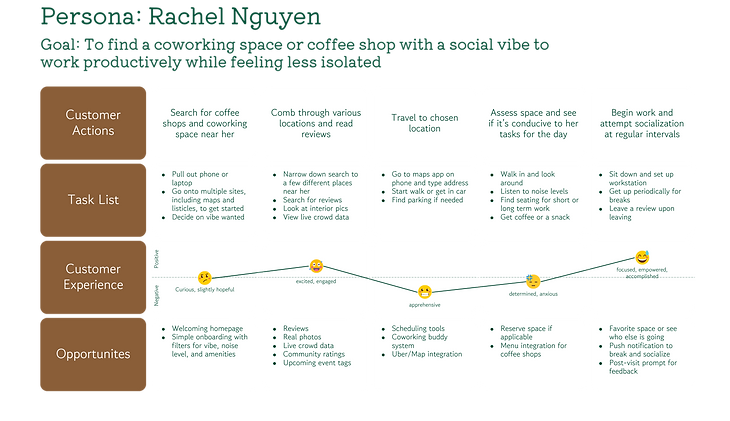
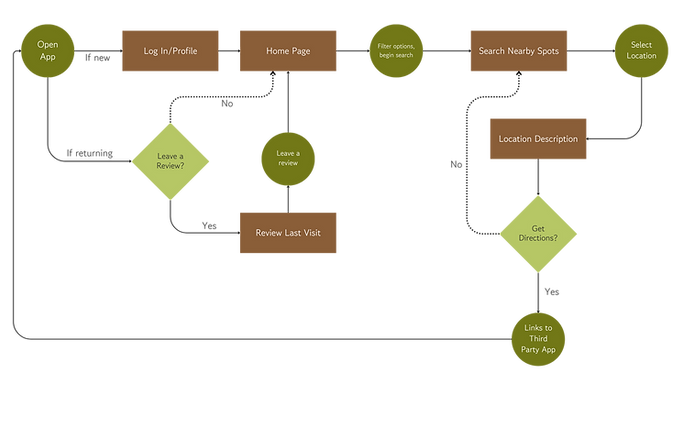
Goal
Upon further analysis of the user data, personas, and journey maps discussed earlier, I crafted a clear goal statement that guided the project's ideation phase...
Our app will help remote and hybrid workers find the perfect work-friendly spots, which will reduce feelings of isolation and improve productivity by connecting them to spaces that match their work style and social needs. We will measure effectiveness by increased repeat visits and user satisfaction through saved favorites, event RSVPs, and feedback ratings.
Ideate
Translate user insights into feature ideas
Ideate
I started with crazy eights and analog wireframes, quickly sketching and revising the initial design multiple times to address the user issues I had identified earlier.
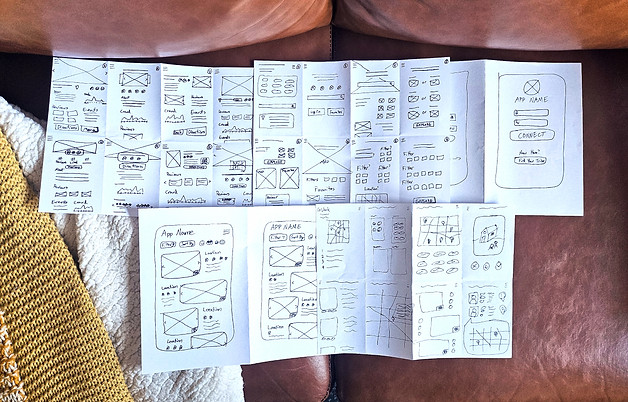
Prototype
Take ideas, test designs, and create the solution
Prototype
The crazy eights dictated the direction of the following Lo-Fi wireframes developed in Figma. These wireframes served as the basis of the prototypes that would be sent out to usability testers.

Test
I carried out detailed usability tests with a fresh group participants to identify any new pain points or design growth opportunities. This hands-on method offered valuable insights into actual user behavior, highlighting both the strengths of the existing user experience and crucial areas for improvement to create a more seamless and intuitive journey.
Pain Point & Implementation
Pain Point: Multiple survey responses highlighted the need for social interaction or quiet focus zones, depending on the day.
Improvement:
-
Add a “Choose the vibe” filter option on the search page (e.g., Quiet, Collaborative, Lively, Networking).
-
Let users sort by social interaction level or ambiance.


Pain Point & Implementation
Pain Point: Users wanted to see habits and most used filters to be incorporated in the app so they can better understand their usage.
Improvement:
-
Add user stats in the Profile Page
-
Floating icons of most used filters
-
Favorite places with highlight reel


Hi-Fi Design
Following the feedback from the second round of interviews, I transitioned into the design phase with a clearer understanding of user needs. I developed hi-fi designs and mockups to examine layout and functionality. With an earthy and cafe centric visual style, the final iteration of CoWork bridges the gap between remote working and a holistic, community centric lifestyle.
Visual Style
I created a distinct design system that blends coffee shop culture with a professional vibe
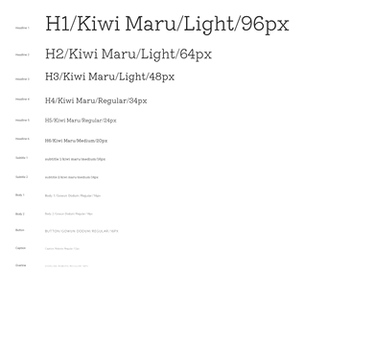
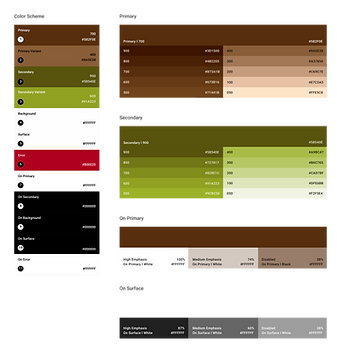
Mock-Ups
 |  |
|---|---|
 |  |
 |  |
Reflect
Introspect and develop skills to help further users
Lessons Learned
Next Steps
Through this project, I gained deeper insight into the emotional and practical challenges remote and hybrid workers face—especially around isolation, work-life boundaries, and finding spaces that truly support their needs. I also learned the value of grounding design decisions in real user pain points, which ensured the final solution was both purposeful and empathetic.
Moving forward, I plan to:
-
Conduct usability testing on the hi-fi prototype to refine interactions and flows.
-
Explore adding richer social features, like coworking buddy matching or shared work sessions.
-
Develop a lightweight MVP to validate core features with real users in live environments.